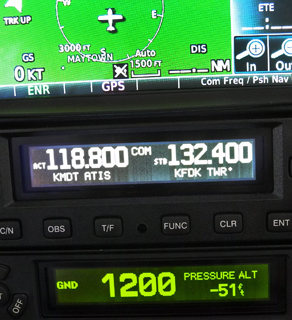
There’s a momentary doubt each time we check in on a new frequency: Did I hear it right? Did I dial it in correctly? Was I given the proper frequency? Garmin’s new radios, the GNC 255A nav/com and the GTR 225 com, take away any uncertainty.
“You always know you have the right frequency because the radio shows you,” said Ben Travis, principal at Smart Avionics near Harrisburg, Pennsylvania, who has installed several of the Garmin units—including the GNC 255A in his own Piper Cherokee 180. “It lets you know exactly who you’re talking to.”
In this case, I was dialing in the tower frequency at Frederick Municipal Airport in Maryland (132.4 MHz). But when I let go of the tuning knob, a window in the standby frequency let me know it was tuned to a ground controller in Newark, New Jersey, on 132.45. The radio has an extensive national database of radio frequencies, and when linked to a GPS, it also lets you know the nearest ATC frequencies (both com and nav). Dial in an airport identifier and it will list all the relevant frequencies for that location. Then choose the frequency you want (ATIS, tower, et cetera) and it’s automatically loaded in the standby window. Ask for the nearest airport or nearest VOR and the radio provides a list of 25.
The GNC and GTR are Garmin’s long-awaited replacements for its popular SL30 and SL40 radios. Like their predecessors, the new radios have a monitor feature that allows the operator to listen in on the standby frequency while keeping another one active. But the new units aren’t slide-in replacements. The GNC and GTR are about one-quarter inch taller than the SL series and have some added pins in the back for new features.
That extra height allows the high-contrast digital displays to show frequencies using impressively big numbers, a very nice feature for those of us whose near vision could use all the help it can get.
Garmin makes it easy for the new radios to communicate with other Garmin avionics. Travis’s Cherokee 180, for example, has a G500 PFD/MFD in which the GNC serves as the number-two nav and com. But the GNC and GTR also connect to Aspen and Avidyne PFDs and MFDs (and many others), and just about any CDI can connect to the nav side of the GNC.
“The GNC is compatible with just about any HSI or nav head on the market,” Travis said. “You won’t have to replace the nav head when you update your radio.”
Travis said the GNC feature that allows it to show bearing, distance, and groundspeed to a station is especially popular among old-school IFR pilots accustomed to distance measuring equipment (DME).
The radio clarity and signal strength of the GNC and GTR units are very good. (Both have up to 10 watts of transmit power, up from 8 watts in the SL series.)
The new units range in price from $3,958 to $4,785 depending on options—a roughly $1,000 jump from the SL series. Preowned SLs can still top $3,000 on the used avionics market.
“The SLs are highly capable radios and they’ve been around for a long time, so people aren’t rushing out to replace them,” Travis said. “But when they do get their hands on the GNCs and GTRs, I think they’ll be pleasantly surprised.”
Email [email protected]..



